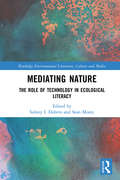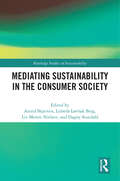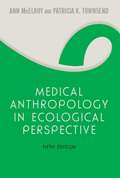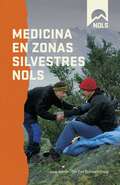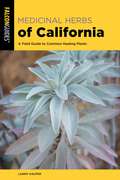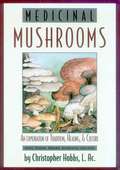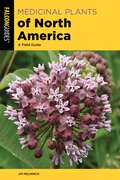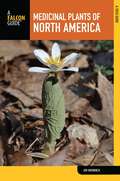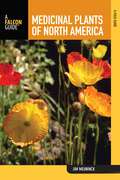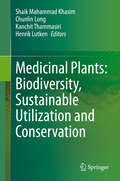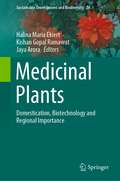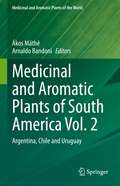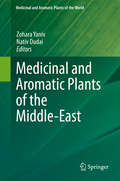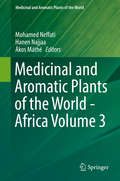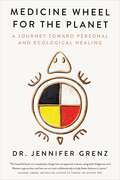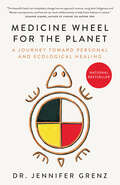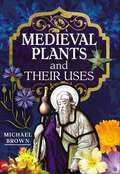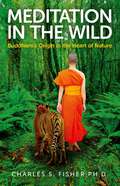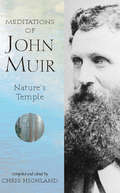- Table View
- List View
Mediating Nature: The Role of Technology in Ecological Literacy (Routledge Environmental Literature, Culture and Media)
by Sean Morey Sidney I. DobrinMediating Nature considers how technology acts as a mediating device in the construction and circulation of images that inform how we see and know nature. Scholarship in environmental communication has focused almost exclusively on verbal rather than visual rhetoric, and this book engages ecocritical and ecocompositional inquiry to shift focus onto the making of images. Contributors to this dynamic collection focus their efforts on the intersections of digital media and environmental/ecological thinking. Part of the book’s larger argument is that analysis of mediations of nature must develop more critical tools of analysis toward the very mediating technologies that produce such media. That is, to truly understand mediations of nature, one needs to understand the creation and production of those mediations, right down to the algorithms, circuit boards, and power sources that drive mediating technologies. Ultimately, Mediating Nature contends that ecological literacy and environmental politics are inseparable from digital literacies and visual rhetorics. The book will be of interest to scholars and students working in the fields of Ecocriticism, Ecocomposition, Media Ecology, Visual Rehtoric, and Digital Literacy Studies.
Mediating Sustainability in the Consumer Society (Routledge Studies in Sustainability)
by Dagny Stuedahl Astrid Skjerven Lisbeth Løvbak Berg Liv Merete NielsenThis book sheds light on the role and impact of sustainability mediation, an effective tool for political authorities and business enterprises to persuade consumers of the integrity of their actions, products, and services.In this era of ecological and societal crises fuelled by increasing consumption, sustainability has become a key buzzword and target to attain. Governments around the world argue that they will meet their sustainability goals through environmental actions, by enabling consumers to make better choices and expecting brands to respond accordingly. At the same time, consumers are overwhelmed by the messaging conveyed in sustainability marketing campaigns, often featuring misleading greenwashing, with political authorities, organisations, and business enterprises all having conflicting interests. In this complex scenario, mediation has become a crucial issue. This book offers a critical and multidisciplinary view of sustainability mediation from experts in the fields of philosophy, consumption research, media studies, fashion, design, and citizenship, offering a unique, holistic view. Each chapter highlights different and problematic aspects of the cultural narratives being communicated, for example, the necessity of growth and the notion of a green economy. They present current theories, methods, indicators, and strategies used to assess and measure the relation between mediation, behaviour, and sustainable development.This book is of interest to scholars, researchers, and postgraduate students in all subject fields concerned with sustainability, including design, visual communication, fashion, consumption, media and journalism, and sustainable development.
Medical Anthropology in Ecological Perspective
by Ann Mcelroy Patricia K TownsendWidespread awareness of emerging infectious diseases and global environmental change makes the ecological perspective of this premier teaching text for medical anthropology as relevant as ever. Integrating biocultural, environmental, and evolutionary approaches to the study of human health, this fifth edition is now thoroughly revised to reflect new developments in the field. Research by human biologists and paleopathologists illuminates the history and prehistory of disease, while the work of cultural and applied anthropologists addresses contemporary health issues. The fifth edition features five new profiles by guest contributors, all leading researchers on health and environment. New topics include community health and disease prevention in urban America; water-borne disease in Ecuador; iodine deficiency in the Himalaya; stress and demographic change in northern Siberia; and participatory action research in Costa Rica. Also included is updated and expanded consideration of refugee health, global aspects of HIV/AIDS, and careers in applied medical anthropology.
Medical Anthropology in Ecological Perspective
by Ann Mcelroy Patricia K TownsendWidespread awareness of emerging infectious diseases and global environmental change makes the ecological perspective of this premier teaching text for medical anthropology as relevant as ever. Integrating biocultural, environmental, and evolutionary approaches to the study of human health, this fifth edition is now thoroughly revised to reflect new developments in the field. Research by human biologists and paleopathologists illuminates the history and prehistory of disease, while the work of cultural and applied anthropologists addresses contemporary health issues. The fifth edition features five new profiles by guest contributors, all leading researchers on health and environment. New topics include community health and disease prevention in urban America; water-borne disease in Ecuador; iodine deficiency in the Himalaya; stress and demographic change in northern Siberia; and participatory action research in Costa Rica. Also included is updated and expanded consideration of refugee health, global aspects of HIV/AIDS, and careers in applied medical anthropology.
Medical Anthropology in Ecological Perspective
by McelroyMcElroy and Townsend (both of the State U. of New York at Buffalo) present the fifth edition of their text introducing the field of medical anthropology. Their aim is to bring together the varied strands of medical anthropology--ethnographic studies of illness beliefs, curing rituals, and herbal medicines; study of the role of disease and climate as factors in human evolution; work on cross-cultural communication in public health; and study of human relationships to their environments in contemporary settings and in the past--using an ecological model and the concept of medical ecology. They present chapters on the ecology of health and disease; interdisciplinary research in health problems; genes, culture, and adaptation; changing patterns of disease and health; the ecology and economics of nutrition; culture, ecology, and reproduction; stress, illness, and healing; health resources in changing cultures; costs and benefits of development; and medical anthropology practices in the 21st century. Interspersed throughout are 16 "profiles" (five new to this edition): case studies that illustrate points made in the rest of the text through examples of current research in medical anthropology, with examples including demographic analysis of census data in post-Soviet Siberian villages, focus group research with inner-city teens in urban Connecticut, and a team project designed to reduce the rates of cholera in rural Ecuador. Annotation ©2009 Book News, Inc. , Portland, OR (booknews. com)
Medicina con plantas sagradas: La sabiduría del herbalismo de los aborígenes norteamericanos
by Brooke Medicine Eagle Stephen Harrod BuhnerEl primer examen en profundidad de los fundamentos sagrados del mundo del herbalismo medicinal de los aborígenes norteamericanos • Revela cómo los chamanes y sanadores “hablan” con las plantas para descubrir sus propiedades medicinales • Incluye las oraciones y canciones medicinales vinculadas con el uso de cada una de las plantas examinadas A medida que los seres humanos evolucionaron en la Tierra, utilizaron plantas para todo lo imaginable --alimentos, armas, canastas, vestimentas, refugio y remedios de salud. En su libro Medicina con plantas sagradas, Stephen Harrod Buhner analiza la relación de larga data entre los pueblos aborígenes y las plantas y examina las técnicas y estados mentales que utilizan estas culturas para comunicarse con el mundo botánico. El autor explora la dimensión sagrada de las interacciones entre seres humanos y plantas --un territorio en el que los humanos experimentamos la comunicación con las plantas como expresiones del Espíritu. Con respecto a cada planta curativa descrita en el libro, el autor presenta sus usos medicinales, normas para su preparación y elementos ceremoniales como las oraciones y canciones medicinales vinculadas con el uso de la planta.
Medicina en Zonas Silvestres NOLS (NOLS Library)
by Tod SchimelpfenigThis vital resource for outdoor enthusiasts is now available for the first time in Spanish. Learn how to prevent, recognize, and treat common medical problems and to stabilize a severely ill or injured patient for evacuation.
Medicinal Herbs of California: A Field Guide to Common Healing Plants
by Lanny KauferMedicinal Herbs of California is the first statewide field guide to more than 70 common medicinal plants of California. This vital addition to the California naturalist&’s shelf will introduce readers to the principles of herbal remedies, history and roots in native cultures, scientific information, and how to find and incorporate medicinal plants into daily life. Inside you&’ll find: Photos and descriptions to help with positive identificationCommon and scientific names and the plant familiesConservation statusModern and traditional usesThe science behind natural phytochemicals that have earned these plants a place in Native American medicine for thousands of years.
Medicinal Herbs of the Rocky Mountains: A Field Guide to Common Healing Plants
by Blake BurgerMedicinal Herbs of the Rocky Mountains introduces the principles of herbal remedies and guides readers through finding, harvesting, cultivating and incorporating more 66 locally abundant medicinal plants into daily life. Complete with color photos and detailed descriptions of each medicinal herb, conservation status, and recipes to put their botanical healing power to work, this guide is a vital addition to the Rocky Mountain naturalists&’ bookshelf.Look inside to find:Modern and traditional uses of medicinal plantsGuidance on ethically harvesting, preparing and storing medicinal plantsTips for cultivation in the gardenPlants found throughout the Dakotas, Montana, Wyoming, Colorado, Utah, and New Mexico.
Medicinal Mushrooms: An Exploration of Tradition, Healing and Culture
by Christopher HobbsMedicinal Mushrooms is a modern handbook for exploring and understanding the rich traditions of healing fungi in Eastern and Western cultures. Author Christopher Hobbs thoroughly documents and details the nutritional and health benefits of over 100 species of edible fungi. Here is the most complete work on the cultural, health-promoting, and medicinal uses of mushrooms ever published!
Medicinal Plants of North America: A Field Guide
by Jim MeuninckThis exquisitely detailed, full-color field guide provides the identification details and practical information needed to find and properly use many of the medicinal plants and wild plant foods that provide chemicals necessary for optimum health and disease prevention. The book takes the user from simple and familiar plants ones that are less common and more difficult to identify. Each of the 122 plant entries includes a color photograph, plant description, and location. Plants are grouped according to how common or rare they are, as well as to where they are found: prairies, woodlands, mountains, deserts, and wetlands.Relevant facts about each plant include toxicity, historical uses, modern uses, as well as wildlife/veterinary uses. Additional information featured in this extraordinary field guide: explanations of how each plant affects the human body; cultural and ethnic uses of medicinal herbs and cooking spices; others creatures who consume the plants; a list of most recommended garden herbs; web site resources, and much more.
Medicinal Plants of North America: A Field Guide
by Jim MeuninckThis exquisitely detailed full-color field guide, by biologist and herbal and medical plant expert Jim Meuninck, provides identification, practical information, and skills for the location of and use of medicinal plants. The pages of this book re-connect us to our roots and the knowledge that medicinal plants and wild plant foods provide the chemicals every body needs to obtain optimum health and prevent disease. Meuninck moves the user from simple and familiar plants toward less common plants more difficult to identify. Each of the 122 plants has a color photograph, plant description, and location. Identification of plants are grouped from common to rare in the environment and where they are found: prairies, woodlands, mountains, deserts, and wetlands. Relevant facts about each plant such as toxicity, historical uses, modern uses, as well as wildlife/veterinary uses are also listed. Additional information included in this extraordinary field guide: explanations of how each plant affects the human body; cultural and ethnic uses of medicinal herbs and cooking spices; others creatures who consume the plants; a list of most recommended garden herbs; web site resources, and much more.The Author's Notes provide personal experiences and novel skills honed from over forty years of experience. They include: gardening tips, recipes, formulations, humor, successful experiences, and more. There is no field guide as all-encompassing and detailed as this one, yet it's portable and easy to understand.
Medicinal Plants of North America: A Field Guide
by Jim MeuninckThis exquisitely detailed, full-color field guide provides the identification details and practical information needed to find and properly use many of the medicinal plants and wild plant foods that provide chemicals necessary for optimum health and disease prevention. The book takes the user from simple and familiar plants to ones that are less common and more difficult to identify. Each of the 122 plant entries includes a color photograph, plant description, and location. Plants are grouped according to how common or rare they are, as well as to where they are found: prairies, woodlands, mountains, deserts, and wetlands.Relevant facts about each plant include toxicity, historical uses, modern uses, as well as wildlife/veterinary uses. Additional information featured in this extraordinary field guide: explanations of how each plant affects the human body; cultural and ethnic uses of medicinal herbs and cooking spices; other creatures who consume the plants; a list of most recommended garden herbs; web site resources, and much more.
Medicinal Plants: Biodiversity, Sustainable Utilization and Conservation
by Shaik Mahammad Khasim Kanchit Thammasiri Chunlin Long Henrik LutkenPlants have been a source of medicines and have played crucial role for human health. Despite tremendous advances in the field of synthetic drugs and antibiotics, plants continue to play a vital role in modern as well as traditional medicine across the globe. In even today, one-third of the world’s population depends on traditional medicine because of its safety features and ability to effectively cure diseases. This book presents a comprehensive guide to medicinal plants, their utility, diversity and conversation, as well as biotechnology. It is divided into four main sections, covering all aspects of research in medicinal plants: biodiversity and conservation; ethnobotany and ethnomedicine; bioactive compounds from plants and microbes; and biotechnology. All sections cover the latest advances. The book offers a valuable asset for researchers and graduate students of biotechnology, botany, microbiology and the pharmaceutical sciences. It is an equally important resource for doctors (especially those engaged in Ayurveda and allopathy); the pharmaceutical industry (for drug design and synthesis); and the agricultural sciences.
Medicinal Plants: Domestication, Biotechnology and Regional Importance (Sustainable Development and Biodiversity #28)
by Kishan Gopal Ramawat Halina Maria Ekiert Jaya AroraMedicinal plant research is an evergreen subject. There is a tremendous increase in popularity of herbal medicine in traditional medicine, ethnomedicine, modern medicine and as over the counter food supplements. Even after this increased demand, supply is neither uniform nor assured as most of these plants are collected from wild. In developing countries of tropical and subtropical regions where majority of herbal drugs are produced, this is not organised sector making it vulnerable to several malpractices, hence standardization of all aspects required. This has also negative impact on biodiversity and conservation of plants as well as supply of uniform material. This book is aimed to provide up to date information about sustainable use of selected medicinal plants, their active ingredients and efforts made to domesticate them to ensured uniform supply. Development of agrotechnology, biotechnology and cultivation practices using conventional and non-conventional methods are presented. Where these efforts will lead the medicinal plant research and future perspective are discussed. The chapters are written by well recognised group leaders in working in the field. The book contains topics on general biology of medicinal plants, their sustainable use and, cultivation and domestication efforts. A uniform chapter structure has been designed to keep consistency. The book will be useful for academicians, agriculturists, biotechnologists and researcher, and industries involved in manufacturing herbal drugs and supplementary products.
Medicinal and Aromatic Plants of South America Vol. 2: Argentina, Chile and Uruguay (Medicinal and Aromatic Plants of the World #7)
by Ákos Máthé Arnaldo BandoniThis volume, as the seventh of the series Medicinal and Aromatic Plants of the World, deals with the medicinal and aromatic plant (MAPs) treasures of the so-called Southern Cone, the three southernmost countries (Argentina, Chile and Uruguay) of South America. Similarly to the previous volumes of the series, the main focus is to collect and provide information on major aspects of botany, traditional usage, chemistry, production / collection practices, trade and utilization of this specific group of plants. The contributors, who are recognized professionals and specialist of the domain, have collected and present state of the art information on 41 species. Most of these are not only of interest from the scientific point of view, but hold also a potential for the prospective utilization of the decreasing, occasionally overexploited / endangered medicinal plant resources of this huge continent. The book is expected to serve as a source of information also on some less known or less studied species. As such the volume is expected to support future research and public health professionals.
Medicinal and Aromatic Plants of the Middle-East
by Nativ Dudai Zohara YanivThe current volume, "Medicinal and Aromatic Plants of the Middle-East" brings together chapters on selected, unique medicinal plants of this region, known to man since biblical times. Written by leading researchers and scientists, this volume covers both domesticated crops and wild plants with great potential for cultivation. Some of these plants are well-known medicinally, such as opium poppy and khat, while others such as apharsemon and citron have both ritual and medicinal uses. All have specific and valuable uses in modern society. As such, it is an important contribution to the growing field of medicinal and aromatic plants. This volume is intended to bring the latest research to the attention of the broad range of botanists, ethnopharmacists, biochemists, plant and animal physiologists and others who will benefit from the information gathered therein. Plants know no political boundaries, and bringing specific folklore to general medical awareness can only be for the benefit of all.
Medicinal and Aromatic Plants of the World - Africa Volume 3
by Ákos Máthé Mohamed Neffati Hanen NajjaaThis volume in the series is devoted to Africa, a continent that possesses a vast treasure of medicinal plants and has produced some exclusive materials for the world market. This volume is expected to strengthen the medicinal plant sector in African countries by making comprehensive information on medicinal and aromatic plants available to policy-makers and entrepreneurs. It can be used to frame effective policies and create an environment conducive to the growth of the plant-based medicine industry, bringing economic benefit to African nations. It will help health organizations to improve the health of their people by using their own resources and a less expensive system of medicine, which is accepted by African society. It could also lead scientific communities to increase R&D activities in the field.
Medicinal and Other Uses of North American Plants: A Historical Survey with Special Reference to the Eastern Indian Tribes
by Charlotte Erichsen-BrownChronological historical citations document 500 years of usage of plants, trees, and shrubs native to eastern Canada, northeastern U.S. Also complete identifying information. 343 illustrations. "...this is the best Dover reprint relative to medicinal plants in fifteen years . . . you can't go wrong." -- Botanic & Herb Reviews.
Medicine Quest: In Search Of Nature's Healing Secrets
by Mark PlotkinIn Medicine Quest, Mark Plotkin moves beyond the Amazon rainforests of his classic Tales of a Shaman's Apprentice to describe the ongoing race to find new medicines for intractable diseases such as AIDS, cancer, diabetes, and tuberculosis in far-flung places all over the world. While highlighting the unlikely marriage of natural products, indigenous wisdom, and biotechnology, Plotkin details discoveries that are producing stunning results in the laboratory: painkillers from the skin of rainforest frogs, anticoagulants from leech saliva, and antitumor agents from snake venom. An entertaining and educational weave of medicine, ecology, ethnobotany, history, exploration, and adventure, Medicine Quest will thrill scientists, naturalists, and armchair explorers, and heighten our appreciation for the inexhaustible therapeutic potential of our natural world.
Medicine Wheel for the Planet: A Journey Toward Personal and Ecological Healing
by Jennifer GrenzA personal journey of bringing together Western science and Indigenous ecology to transform our understanding of the human role in healing our planetI used to be an ecologist. . . . Now, I am a community gatherer, working to help bring healing beyond just the land. I am a story-listener. I am a storyteller. I am a shaper of ecosystems. I work on bringing communities together, in circle, to listen to each other. A farm kid at heart, and a Nlaka&’pamux woman of mixed ancestry, Dr. Jennifer Grenz always felt a deep connection to the land. However, after nearly two decades of working as a restoration ecologist in the Pacific Northwest, she became frustrated that despite the best efforts of her colleagues and numerous volunteers, they weren&’t making the meaningful change needed for plant, animal, and human communities to adapt to a warming climate. Restoration ecology is grounded in an idea that we must return the natural world to an untouched, pristine state, placing humans in a godlike role—a notion at odds with Indigenous histories of purposeful, reciprocal interaction with the environment. This disconnect sent Dr. Grenz on a personal journey of joining her head (Western science) and her heart (Indigenous worldview) to find a truer path toward ecological healing. In Medicine Wheel for the Planet, building on sacred stories, field observations, and her own journey, Dr. Grenz invites readers to share in the teachings of the four directions of the medicine wheel: the North, which draws upon the knowledge and wisdom of elders; the East, where we let go of colonial narratives and see with fresh eyes; the South, where we apply new-old worldviews to envision a way forward; and the West, where a relational approach to land reconciliation is realized. Eloquent, inspiring, and disruptive, Medicine Wheel for the Planet circles around an argument that we need more than a singular worldview to protect the planet and make the significant changes we are running out of time for.
Medicine Wheel for the Planet: A Journey toward Personal and Ecological Healing
by Dr. Jennifer Grenz"This beautiful book can completely change how we approach science, using both Indigenous and Western perspectives, and how we can work collaboratively to help foster balance in nature." —Suzanne Simard, bestselling author of Finding the Mother TreeA farm kid at heart, and a Nlaka'pamux woman of mixed ancestry, Dr. Jennifer Grenz always felt a deep connection to the land. However, after nearly two decades of working as a restoration ecologist in the Pacific Northwest, she became frustrated that despite the best efforts of her colleagues and numerous volunteers, they weren't making the meaningful change needed for plant, animal and human communities to adapt to a warming climate. Restoration ecology is grounded in an idea that we must return the natural world to an untouched, pristine state, placing humans in a godlike role—a notion at odds with Indigenous histories of purposeful, reciprocal interaction with the environment. This disconnect sent Dr. Grenz on a personal journey of joining her head (Western science) and her heart (Indigenous worldview) to find a truer path toward ecological healing.In Medicine Wheel for the Planet, building on sacred stories, field observations and her own journey, Dr. Grenz invites readers to share in the teachings of the four directions of the medicine wheel: the North, which draws upon the knowledge and wisdom of elders; the East, where we let go of colonial narratives and see with fresh eyes; the South, where we apply new-old worldviews to envision a way forward; and the West, where a relational approach to land reconciliation is realized. Eloquent, inspiring and disruptive, Medicine Wheel for the Planet circles toward an argument that we need more than a singular worldview to protect the planet and make the significant changes we are running out of time for.
Medieval Plants and their Uses
by Michael BrownPlants were an essential part of medieval life. Most people lived in houses made of wood and thatch, which often accidentally burned down when they cooked their food or huddled over wood fires to keep warm. People wore linen clothing dyed with plants. They drank ale, cider and wine as they danced to music played on wooden instruments. Beauty, love and seduction could all be made easier with a few herbal preparations. If you became ill, plants provided many of the cures. The unwary may have mistaken a poisonous plant for one that was good to eat, with fatal consequence. Others may have used the poisonous plant to remove an unwanted rival. Some plants had magical properties. The mysterious mandrake could kill anybody who tried to dig it up without taking the appropriate precautions. Demons could be summoned or dismissed by the aid of plants. The church used powerful incense to clean the air and induce a sense of religious euphoria. This book is designed to give a broad introduction to the plants that were used during the medieval period. With many colorful photos, a list of plants that were available and some original medieval recipes to try, you can set out on an adventure to explore the wonderful world of medieval plants.
Meditation in the Wild: Buddhism's Origin in the Heart of Nature
by Charles S. FisherMeditation in the Wild takes the reader on an adventure with the Buddhist forest monks and hermits of the last 2500 years. Walking into jungles and living on mountain sides, their encounters with nature teach us about the meaning of life and death, our struggles with our own minds and how we treat each other. Sitting with tigers, biting insects and bamboo shoots they looked on life compassionately. They remind us of who we are and what we have become.
Meditations of John Muir
by Chris HighlandEditor Chris Highland pairs 60 insightful Muir quotes with selections from other celebrated thinkers and spiritual texts. Take this pocket-size guide with you on backpacks, nature hikes, and camping trips.
